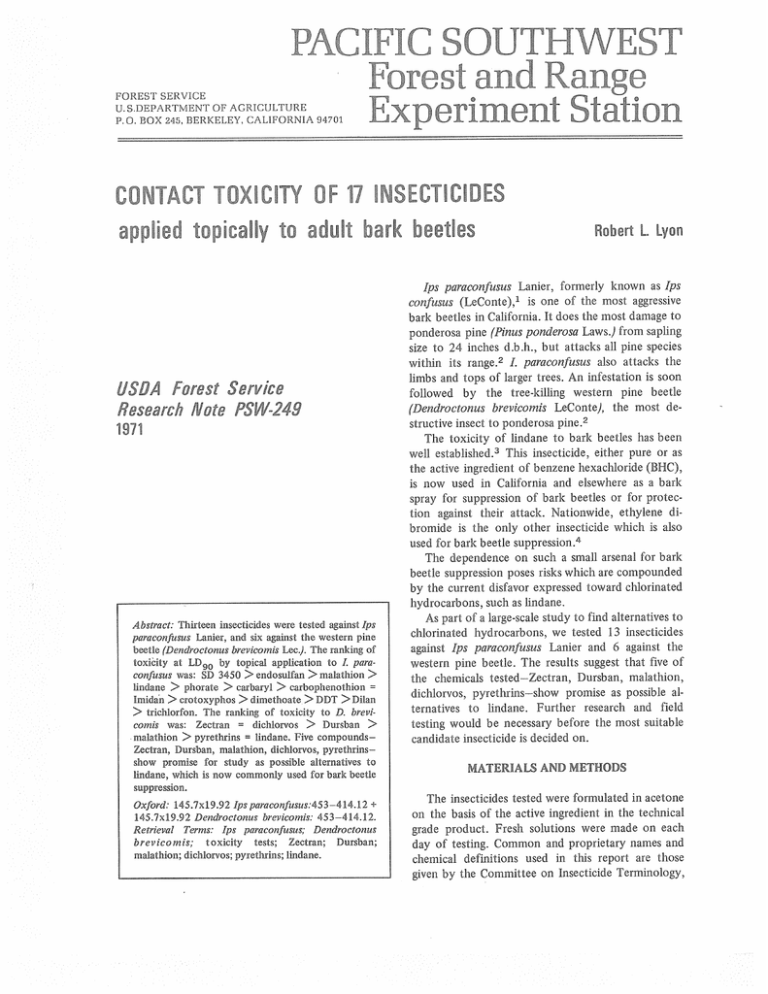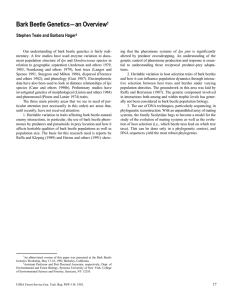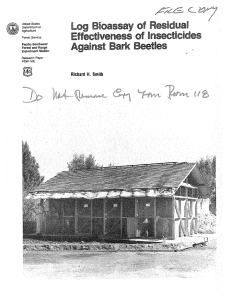C SOUTH ank Range
advertisement

C SOUTH ank Range F O R E S T SERVICE U. S.DEPARTWIENT O F AGRICULTURE P. 0. BOX 245, BERKELEY, CALIFORNIA 94701 CONTACT TO Robert L. Lyon USDA Forest Service Research Note PSW-249 1971 Absaaet: Thbteen insecticides were tested against Ips paracoafisus Lanier, and six agahst the western pine nu~ Lec.). The rankhg of beetle ( D e n c k s ~ ~ f ~brevicomis toxikity at LDQO by topical appGcation to I. pamcoY1Jusus was: SD 3450 endosulfm malathion > > > > > > > > > > hndane phorate carbayl caPzbophenothion = Ilmidin crotoxyphos dimethoate DDT > ~ i l a n trichlorfon. The rankkg of toxicity to D. bbrevieomis was: Zectran = dichlonros Dursban malathion pyrethins = Endane. Five compoundsZectran, Dursban, malathion, dichlomos, pyrethrhsshow promise for study as possible alternatives Lo h d a n e , which is now commonly used for bark beetle supp1ession. > > > Oxford: 145.7~19.92Ips pa~'ldcoa~sus:Lg53-414.12+ 145.7x19.92 Dendroctonus brevicomis: 453-414.12. Reh.ievaE Terms: Ips pabraconfusus; Deadroctonus brev ico m is; toxicity tests; Zectran; Dursban; malathion; dichlomos; pyrelhrins; lhdane. Ips paraconfiasus Lanier, formerly known as Ips confusus (LeConte),l is one of the most aggressive bark beetles in California. It does the most damage to ponderosa pine (Pinus ponderosa Laws.) from sapling size to 24 inches d.b.h., but attacks all pine species wi"ln its range.2 I. paraconfusus also attacks the limbs and tops of larger trees. An infestation is soon followed by the tree-killing western pine beetle (Den&octonus bvevicomis keC onte), the most destructive insect to ponderosa pine.2 The toxicity of lindane to bark beetles has been This insecticide, either pure or as well e~tablished.~ the active ingredient of benzene hexachloride (BHG), is now used in California and elsewhere as a bark spray for suppression of bark beetles or for protection againsMheir attack. Nationwide, ethylene dibromide is the only other insecticide which is also used for bark beetle s u p p r e s s i ~ n . ~ The dependence on such a small arsenal for bark beetle suppression poses risks which are compounded by the current disfavor expressed toward chlorinated hydrocarbons, such as lindane. As part of a large-scale study to find alternatives to chlorinated hydrocarbons, we tested 13 insecticides against Ips paraconfusus Lanier and 6 against the weskrn pine beetle. The results sugges"chat five of the chemicals tested-Zectran, Dursban, malathion, dichlorvos, pyrethrins-show promise as possible alternatives to lindane. Further research and field testing would be necessary before the most suitable candidate insecticide is decided on. MATERIAU AND METHODS The insecticides tested were formulated in acetone on the basis of the active ingredient in the technical grade product. Fresh solutions were made on each day of testing. Common and proprietary names and chemical definitions used in this report are those given by the Committee on Insecticide Terminology, Entomological Society of A m e r i ~ a .The ~ insecticide lindane able 2). On the basis of average insect SD 3450 is not cited. Its chemical name is: mortalities, tlre ranking of toxicity was Zectran = 5 ,$,7,8,9,9-hexachloro-l,4,4a,5,8,8a-hexahydrodichlowos > Dursban > malathion >- pyrethrins = 1,4:S,8-dimethanophthalazine. lindane. Testing procedures were similar to those described Table 2-Mort~lity of westerr2 pine beetle adults treated with by L ~ y o n Acetone . ~ ~ ~ solutions were applied topically six insectkides at three dosage levels to the venter of the adult beetle at the rate of I 6-11/10 I ~ o & a ~attdosage ~ l of mg. body weigl-ft. The insects were held after treatment singly in size No. 000 gelatin capsules. Dead Insecticide insects were counted 3 days later. Percent The insecticides were tested on 6. pavaconfusus at four to six different concenkrations and replicated 110 100 100 100 Zectran 60 100 aoo Dichlorvos usually two t o five times. Full dosage-mortality 96 100 31 00 110 Dursban regression curves were obtained for tlvs insect by 85 100 100 110 Malathion using a computer program of probit a n a l y ~ i s .Addi~ 100 53 100 110 hrethrins "conal candidate insecticides were tested at three 62 95 100 180 Lindane concentration levels agkst the western pine beetle. RESULTS At ED,, , three insecticides-SD 3450, endosulfan, and malathon-were more toxic "clan lindane to I. paraconfusus, though the differences were not large (tabk I; fig. I). Malathion was less toxic at the LD,, level. All six insecticides tested on the western pine beetle were as toxic as or sEghtly more toxic than Table 1- abxicihy of 13 insecticides applied t o p k d l y to Ips ~amconfususadults I Number &. /g body weight SD 3450 Endosulfan Mdathion Llindane (standard) Phorate Cabsyl Cabophenothion Imihn Crotoxyphos Dimethoate DDT Di?lan 'Ifrichlorfon ~ L = dose D lethal ~ ~to 50 percent of sample; LDgO= dose lethal to 9 percent of sample. 2~oxicityrelative to findane: LDS0 lindane = toxicity index. LD50 (,, candidate l~orrected for natural moaality by Abbott's formula; natural mortaEi;y from treatment with acetone alone was 14 percent. T h e five c o m p o u n d s - Z e c t r a n , Dursban, malatl~on,dichlorvos, and pyrethrhs-appear to be the most promising candidates for further study, 'Ifl~ey are at least as toxic as lindane and, unlike chlorinated hydrocarbons, do not have the "eoublesome quality of persistence in the environment. They may, however, have insufficient persistence in bark. Residual action in bark is of considerable importance in bark beetle suppression, as it tends to increase the effectiveness of sprays and their flexibility of use. Residual life of these five compounds, when applied to bark, is not now known. Laboratory and field tests with deposits in bark are needed "I assess fully their potential for use agakst bark beetles. , NOTES 'kanier, 6. N. Biosystematics o f North Arrzerican Ips (Coleoptera: Scolyt id@ Hoppirzg9sgfoup IX.Can. Entomol. 102(9): 1139-1163, 1970. 2~truble, George R., and Hall, Ralph C. The California five-spined engraver-its biology avzd eo~ztml.U.S. Dep. Agr. Ckc. 964, 21 p., illus. 1955. 3 ~ y o n ,Robert L. Structure and toxicity of insecticide deposits for contml o f bark beetles. U.S. Dep. Agr. Tech. Bull. 1343, 59 p. 1965. on, Robert L. Formulation and s2.Yucture of residual insecticides for bark beetle cont'rol. In, Advances in Chemistry Ser. 86: 192-206. R. B;. Gould, ed., Washington, D.C.: Amer. Chem. Soc.1949. '~illings, Samuel C. Consolidated list o f approwd conzmorz names of insecticides and c e r t ~ i nother pesticL"des. Bull. Dosage ( p . g . 4 . body weight) Figure 1-Dosage-mortality curves f i r 13 insecticides upplied topical& to Ips pamconfusus adults. Entomol. Soc. Amer. 1143): 204-213, 1945; 1243): 356-35'7, 1966; 1344): 342, 1967; 14(4): 289, 1968; 1564): 380, 1969. he assistance of Burton B. Combs and Peter Letchworth in the bioassay is gratefully acknowledged. ?Ly on, Robert L. Toxicity of severa.rak residual-type insect; cides is selected western bark beetles. J . Econ. Entomol. 5262): 323-327, 1959. 8&ovided by Gerald S. Walkon, U.S.Forest Service, Upper Daby, Pa. The Author ROBERT L, LYON, a research entomologist, is responsible for insect culture and bioassay in the Station's studies in the evaluation of chemical insecticides. He attended New Y ark State University College of Forestry, where he earned B.S. (1953) and M.S. (1954) degrees. He received a doctorate in entomology (1961) from the University of CaEfornia, Berkeley. This pUbGciltion reports $esearch involving psticides. It does not c o n t ~ n recommendations for their use,nos; does it imply that the uses discussed here have uses of pesticides must be ne@stered by appropiate State been regjstered, andlor Federal agencies before they can be recommended. : I CAWION: Pesticides c m be injurious to Zlumkuas, domestic animals, deskable plants, and fish or other wildl8e-if they ase not handled or applied properly. Use a11 pesticides selectively and ca~enTuiHy,Follow recommended practices for the $ i s p o d of surplus pesticides and pesticide containers. GPO 981-314 ent of Agdcdme The Forest Semice of the U.S, Dep . . . Conducts forest and range research at more than 75 locations from Puerto Rim to Alaska and Hawaii. . . . ParGcipates with all State forestny agencies in cooperative programs to protect and hprove the Nation's 395 maion acres of State, Bocd, arad private forest lands. . . ; Maages and protects the 187-million-acre National Forest System for sustained yield sf its mmy prohcts and services. ' The Pacific Southwest Forest and Rmge Experiment StaGon represents the research brrmch of the Forest Service in Cdifomia and Hawaii.





